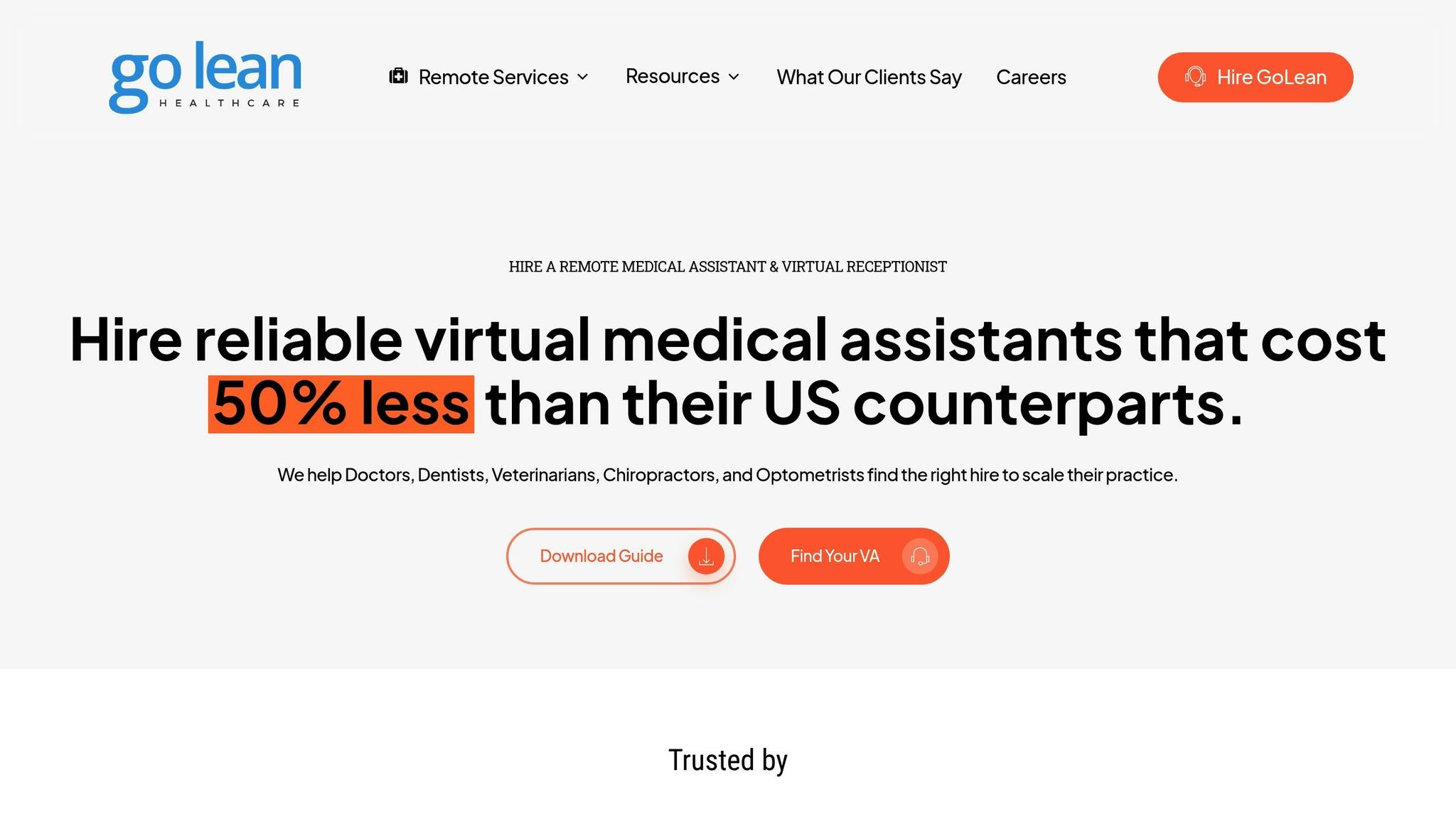Virtual assistants (VAs) are transforming telehealth by improving patient trust and operational efficiency. They handle tasks like scheduling, insurance verification, and EMR system updates while ensuring HIPAA compliance. Here’s why they matter:
- Key Skills: HIPAA compliance, EMR expertise, patient communication, medical billing.
- Bilingual Support: Breaking language barriers, especially for Spanish-speaking patients.
- Efficiency: Dedicated VAs for consistent, personalized service.
- Data Security: Adherence to strict protocols ensures patient trust.
Quick Comparison:
| Aspect | Virtual Assistants | In-Person Staff |
|---|---|---|
| First Impressions | Engaging phone/email presence | Physical interaction and appearance |
| Response Time | Quick and focused on admin tasks | May face delays due to multitasking |
| Communication Style | Clear, structured, often bilingual | Includes non-verbal cues |
| Data Security | HIPAA-compliant practices | Direct oversight in clinics |
| Availability | Consistently available, no fatigue | Limited by shifts and workload |
VAs complement in-person staff by handling routine tasks efficiently, allowing clinics to focus on patient care. Together, they create a balanced telehealth experience.
What is a Virtual Medical Assistant?
1. GoLean Virtual Assistants
GoLean’s virtual medical assistants are well-prepared to handle sensitive patient information, thanks to their thorough training in HIPAA regulations and EMR systems before they even start. This preparation allows them to hit the ground running, as noted by many healthcare providers.
"My experience with GoLean has been amazing. I was worried about having to train my VA but he already knows how to use the EMR and was already certified for customer service, HIPAA, and more. It eliminated extensive training requirements, since he got to work right away." [1]
GoLean takes patient trust seriously, especially in telehealth. Their model assigns each virtual assistant exclusively to one practice. This approach ensures the assistant becomes deeply familiar with the practice’s operations, from protocols and patient needs to EMR systems and billing procedures. The result? Consistent, personalized service that enhances patient trust.
For practices serving diverse populations, GoLean provides bilingual support alongside a Business Associate Agreement (BAA). This ensures clear communication with patients while safeguarding data security and compliance.
GoLean VAs excel at maintaining patient trust by focusing on key areas:
| Function | How It’s Achieved |
|---|---|
| Patient Data Security | HIPAA-compliant practices and secure EMR access |
| Communication | Support via email, chat, video, and phone |
| Administrative Tasks | Exclusive focus on one practice to ensure efficiency |
| Cultural Sensitivity | Bilingual capabilities and cultural awareness |
| Compliance | BAA coverage and regular HIPAA certification |
This structured approach has made GoLean VAs a reliable choice for telehealth practices, boosting patient engagement and improving operational efficiency across various medical fields.
sbb-itb-109dad4
2. In-Person Medical Staff
Face-to-face interactions have always been key to building patient trust.
Non-verbal cues like eye contact, nodding, and other affirmative gestures help show empathy and understanding. These small actions create an atmosphere where patients feel heard and valued.
By paying attention to a patient’s facial expressions and body language, in-person staff can quickly assess whether the patient understands and adjust their explanations accordingly. This approach is especially helpful when discussing complex procedures or sensitive topics, ensuring patients feel supported and informed.
Key factors that help in-person medical staff build trust include:
- Physical Presence: Offers a sense of security and a personal connection.
- Controlled Environment: Provides a professional and consistent setting.
- Emotional Awareness: Helps staff recognize and address patient anxiety or discomfort.
However, staying consistently empathetic and professional can be tough, especially during busy shifts or when dealing with high patient volumes. Fatigue and time constraints may sometimes affect the quality of engagement.
Comparing Virtual and In-Person Support
In telehealth, virtual assistants and in-person staff each contribute to building patient trust in distinct ways. Here’s a comparison of how these two support models operate:
| Aspect | Virtual Assistants | In-Person Staff |
|---|---|---|
| First Impressions | Friendly and engaging phone presence | Professional appearance with immediate physical interaction |
| Response Time | Quick to address patient requests | May be delayed by physical tasks or other responsibilities |
| Communication Style | Clear and structured | Includes non-verbal cues for immediate understanding |
| Data Security | HIPAA-compliant with standardized protocols | Direct oversight in a controlled setting |
| Language Support | Often bilingual, serving diverse populations | Limited by staff language capabilities |
| Availability | Consistently available without physical fatigue | Affected by shift schedules and workload demands |
Healthcare professionals often highlight the benefits of virtual assistants. Dr. Trishanna Sookdeo of Sookdeo Family Medicine INC shares:
"Our team is always delighted by my VA’s bright and happy disposition. At any time of the day, you’ll find him happily answering the phone whether it’s for our patients or our staff and physicians. He is such a delight to work with and we can’t imagine our office without him" [1].
Virtual assistants excel at handling administrative tasks consistently, which strengthens patient trust. On the other hand, in-person staff provide a physical presence and emotional connection that virtual support cannot replicate. Together, these models complement each other, creating a balanced telehealth experience that combines personal interaction with efficient, reliable support.
Key Findings and Future Outlook
Our analysis highlights important insights into how telehealth builds trust, especially when comparing virtual and in-person support. Virtual assistants stand out for their ability to maintain consistent communication and handle administrative tasks efficiently.
Telehealth trust-building is progressing in three key areas:
| Dimension | Current State | Future Direction |
|---|---|---|
| Data Security | HIPAA-trained virtual assistants with BAA agreements | Stronger focus on HIPAA compliance and advanced data protection |
| Communication | Bilingual support and multi-channel accessibility | Broader language options and innovative communication tools |
| Administrative Efficiency | Proficiency in EMR systems and dedicated support teams | Greater use of technology to simplify administrative workflows |
These areas highlight how virtual support is becoming more embedded in telehealth practices, reflecting the growing reliance on these tools to enhance patient care.
Healthcare providers are increasingly recognizing the importance of virtual assistants in earning patient trust. As discussed earlier, virtual assistants are well-positioned to drive this shift.
In the coming years, telehealth will benefit from:
- Improved Security Measures – Stricter adherence to HIPAA regulations and stronger data protection systems
- Advanced Training – Continuous skill development in EMR systems and patient interaction
- Cultural Competency – Expanded bilingual and multicultural support for diverse patient needs
- Technology Integration – Smoother coordination between virtual and in-person care teams
The shift toward virtual support in healthcare continues to gain momentum. By blending the efficiency of virtual assistants with the personal connection of in-person staff, hybrid care models are set to deliver more reliable and patient-centered telehealth experiences. This evolution ensures high-quality care while meeting the demands of a modern healthcare system.




